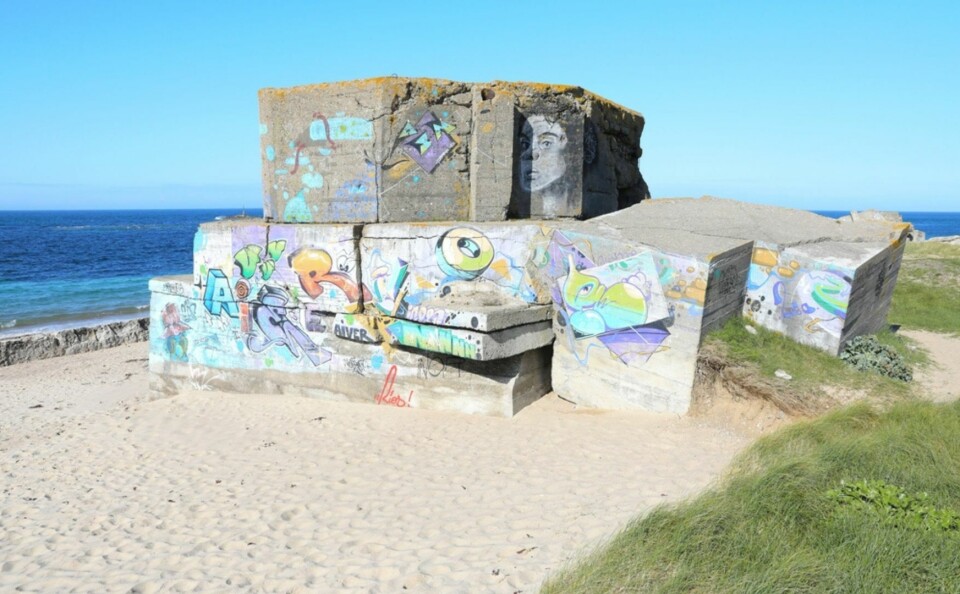-
Duck Cold! Four French phrases to use when it is freezing outside
We remind you of French expressions to use to describe the drop in temperature
-
When and why do we say le moral dans les chaussettes?
We explore this useful expression that describes low spirits
-
The origins and meaning of tirer les marrons du feu
As Christmas approaches, we look at a phrase to describe someone who takes advantage of a situation
Should Nazi defences be preserved or forgotten along French coast?
The WW2 bunkers in Normandy are linked to D-Day and victory, but Atlantic fortifications divide opinion in coastal towns

Eighty years after Nazi Germany built its system of fortifications along the French coast, many towns are still unsure what to do with the physical remnants of this painful history.
While mostly associated with the Normandy beaches, the Atlantic Wall system of coastal defences, built between 1942 and 1944, stretched from Norway to France’s border with Spain.
Some of the sites have become museums and memorials, but many of the remains have been forgotten or left to deteriorate.
Jean-Loup Ménochet, a historian and tour guide based on the Basque coast, said: “In France, we have a very negative image of the bunkers, except in Normandy, where they are linked to D-Day and victory.”
Read more: Meet Frédéric Sommier, director of Normandy's D-Day museum
‘Biarritz doesn’t want to talk about them’
The area was heavily fortified, partly in response to Operation Myrmidon, an abortive raid on south west France in 1942, and partly to protect the transport of iron ore from Spain.
“Biarritz was also chosen by the Nazis as an R&R resort for soldiers,” Mr Ménochet said.
Several fortifications were built into the cliffs in Biarritz. “These large underground facilities were extremely well developed, with a system for recycling air, cisterns, and electricity.
“Near the aquarium, there are two command posts that were dug into the rock, and which are in perfect condition.”
These structures are virtually unique for the Atlantic Wall, he said, built over five levels and using complex technology such as an automatic flamethrower system.
“The problem is, the town of Biarritz doesn’t want to talk about them. Certain towns look to utilise the bunkers as historical monuments, and others prefer sun and surf.”
Read more: Painful and important history of France’s WW2 bunkers
‘Today they are dirty, graffitied, used as public toilets’
Many towns lack the funds to transform the sites into public spaces. In the case of Biarritz, he believes a lack of willingness is the main obstacle.
“It’s a shame, as there are examples in Europe of German military sites being converted into wonderful event spaces. The Biarritz facility could make an extraordinary contemporary art gallery.”
Numerous bunkers were also built on the beaches of the Basque coast and here, too, Mr Ménochet says a negative image has endured due to a lack of communication.
“For older people, they symbolise the horrors of war. For younger generations, there is sometimes a slight interest, but mostly there is an aversion: they are dirty, graffitied, used as public toilets.”
To further complicate matters, many of the inland structures are found on private land.
Hundreds of thousands of French workers built them
For the 75th anniversary of the Normandy landings in 2019, photographer Antoine Cardi took a series of photos of sites where fortifications had been destroyed or built upon.
Mr Cardi, who trained as a historian, said: “Today, they are leisure facilities like mini-golf courses, houses, or we see nothing at all.
“In Ouistreham, there is a casino built on the foundations of a former bunker, and there are lots of examples of houses built on the foundations.”
Hundreds of thousands of French workers volunteered or were forced to build the Atlantic Wall.
Over the past two decades, retiree Jean-Paul Lescorce has cleaned up dozens of bunkers at Soulac-sur-Mer (Gironde) in memory of his father, who was part of the STO forced labour system.
Related articles
See inside: French couple renovates war bunker into accommodation
Varian Fry: The American who was a ‘Schindler in France’
The remarkable WWII story of a British secret agent in occupied France
























